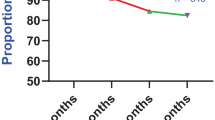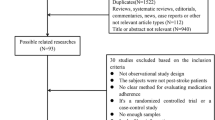Abstract
Background
Medication adherence is important for secondary stroke prevention. However, suboptimal adherence to medication among patients after stroke or transient ischemic attack is reportedly 30.9%. We assessed medication adherence of Korean stroke survivors within 1 year of acute ischemic stroke and identified factors that influence adherence.
Methods
We consecutively enrolled ischemic stroke survivors who visited the Department of Neurology of a university hospital from March 9 to June 15, 2016. Data were collected by face-to-face interviews using a structured questionnaire which assessed general characteristics, clinical characteristics, medication beliefs, social support, and depression. Medication adherence was measured using the 8-item Morisky Medication Adherence Scale. Multiple logistic regression was used to identify factors independently associated with medication adherence.
Results
Of the total 250 participants, 183 (73%) were in the optimal adherence group. Age (p = 0.035), smoking (p = 0.020), number of prescribed medicines (p = 0.037), frequency of daily doses (p = 0.040), and beliefs about medication (p < 0.001) were associated with medication adherence. Optimal medication adherence was associated with being a non-smoker (OR, 3.19; 95% CI, 1.29–7.87; p = 0.012), more prescribed medicines (OR, 1.27; 95% CI, 1.05–1.54; p = 0.014), less frequency of daily doses (OR, 0.37; 95% CI, 0.18–0.79; p = 0.010), and stronger beliefs about medication (OR, 1.09; 95% CI, 1.03–1.15; p = 0.004).
Conclusion
To improve medication adherence of stroke survivors, post-stroke care should focus on bolstering patients’ belief in the necessity of medication and encouraging lifestyle modifications, such as quitting smoking, as well as prescribing medicine with simple regimens.

Similar content being viewed by others
References
Korean Statistical Information Service (KOSIS). Annual report on the cause of death statistics 2016 [Internet] Daejeon: Statistics Korea; [cited 2017 Oct 25]. Available from: http://kosis.kr/eng/search/searchList.do.
Kim J, Son M. National health insurance statistical yearbook. Seoul: Health Insurance Review and Assessment Service and National Health Insurance Service; 2015.
Kim JY, Kang K, Kang J, Koo J, Kim D-H, Kim BJ, et al. Executive summary of stroke statistics in Korea 2018: a report from the epidemiology research Council of the Korean Stroke Society. J Stroke. 2019;21:42–59.
Chan JCN, Malik V, Jia W, Kadowaki T, Yajnik CS, Yoon K-H, et al. Diabetes in Asia. JAMA. 2009;301:2129.
Kokubo Y. Prevention of hypertension and cardiovascular diseases. Hypertension. 2014;63:655–60.
Choi-Kwon S, Kim JS. Lifestyle factors and risk of stroke in Seoul, South Korea. J Stroke Cerebrovasc Dis. 1998;7:414–20.
Burn J, Dennis M, Bamford J, Sandercock P, Wade D, Warlow C. Long-term risk of recurrent stroke after a first-ever stroke. Oxfordshire Community Stroke Proj Stroke. 1994;25:333–7.
Kwok CS, Shoamanesh A, Copley HC, Myint PK, Loke YK, Benavente OR. Efficacy of antiplatelet therapy in secondary prevention following lacunar stroke. Stroke. 2015;46(4):1014–23.
Shaya FT, El Khoury AC, Mullins CD, et al. Drug therapy persistence and stroke recurrence. Am J Manag Care. 2006;12(6):313–9.
Morgan CL, McEwan P, Tukiendorf A, Robinson PA, Clemens A, Plumb JM. Warfarin treatment in patients with atrial fibrillation: observing outcomes associated with varying levels of INR control. Thromb Res. 2009;124:37–41.
Wagner ML, Khoury JC, Alwell K, Rademacher E, Woo D, Flaherty ML, et al. Withdrawal of antithrombotic agents and the risk of stroke. J Stroke Cerebrovasc Dis. 2016;25(4):902–6.
Sibon I, Orgogozo J-M. Antiplatelet drug discontinuation is a risk factor for ischemic stroke. Neurology. 2004;62(7):1187–9.
Hong K-S, Yegiaian S, Lee M, Lee J, Saver JL. Declining stroke and vascular event recurrence rates in secondary prevention trials over the past 50 years and consequences for current trial design. Circulation. 2011;123:2111–9.
Katsanos AH, Filippatou A, Manios E, Deftereos S, Parissis J, Frogoudaki A, et al. Blood pressure reduction and secondary stroke prevention. Hypertension. 2017;69:171–9.
Kernan WN, Viscoli CM, Furie KL, Young LH, Inzucchi SE, Gorman M, et al. Pioglitazone after ischemic stroke or transient ischemic attack. N Engl J Med. 2016;374(14):1321–31.
Montecucco F, Quercioli A, Mirabelli-Badenier M, Luciano Viviani G, Mach F. Statins in the treatment of acute ischemic stroke. Curr Pharm. 2012;13:68–76.
Hong K-S, Lee JS. Statins in acute ischemic stroke: a systematic review. J Stroke. 2015;17:282–301.
Kobayashi A, Tamura A, Ichihara T, Minagawa T. Factors associated with changes over time in medication-taking behavior up to 12 months after initial mild cerebral infarction onset. J Med Invest. 2017;64(1.2):85–95.
Al AlShaikh S, Quinn T, Dunn W, Walters M, Dawson J. Predictive factors of non-adherence to secondary preventative medication after stroke or transient ischaemic attack: a systematic review and meta-analyses. Eur Stroke J. 2016;1(2):65–75.
Kim YT, Park KS, Bae SG. Predictors of persistence and adherence with secondary preventive medication in stroke patients. J Agric Med Community Health. 2015;40(1):9–20.
Vrijens B, De Geest S, Hughes DA, Przemyslaw K, Demonceau J, Ruppar T, et al. A new taxonomy for describing and defining adherence to medications. Br J Clin Pharmacol. 2012;73:691–705.
Ji R, Liu G, Shen H, Wang Y, Li H, Peterson E, et al. Persistence of secondary prevention medications after acute ischemic stroke or transient ischemic attack in Chinese population: data from China National Stroke Registry. Neurol Res. 2013;35:29–36.
Bushnell CD, Olson DM, Zhao X, Pan W, Zimmer LO, Goldstein LB, et al. Secondary preventive medication persistence and adherence 1 year after stroke. Neurology. 2011;77:1182–90.
Kim LS. The experience of the stroke patients about the use of oriental medicine. J Korean Publ Health Nurs. 1997;11(1):82–92.
Kernan WN, Ovbiagele B, Black HR, Bravata DM, Chimowitz MI, Ezekowitz MD, et al. Guidelines for the prevention of stroke in patients with stroke and transient ischemic attack. Stroke. 2014;45:2160–236.
Faul F, Erdfelder E, Buchner A, Lang A-G. Statistical power analyses using G* power 3.1: tests for correlation and regression analyses. Behav Res Methods. 2009;41(4):1149–60.
Osterberg L, Blaschke T. Adherence to medication. N Engl J Med. 2005;353(5):487–97.
Sabaté E. Adherence to long-term therapies: evidence for action: World Health Organization; 2003.
Morisky DE, Ang A, Krousel-Wood M, Ward HJ. Predictive validity of a medication adherence measure in an outpatient setting. J Clin Hypertens. 2008;10(5):348–54.
Moon SJ, Lee W-Y, Hwang JS, Hong YP, Morisky DE. Accuracy of a screening tool for medication adherence: a systematic review and meta-analysis of the Morisky medication adherence scale-8. PLoS One. 2017;12:e0187139.
Lee GKY, Wang HHX, Liu KQL, Cheung Y, Morisky DE, Wong MCS. Determinants of medication adherence to antihypertensive medications among a Chinese population using Morisky medication adherence scale. PLoS One. 2013;8:e62775.
Jung JH, Kim YH, Han DJ, Kim KS, Chu SH. Medication adherence in patients taking immunosuppressants after kidney transplantation. J Korean Soc Transplant. 2010;24:289–97.
Horne R, Weinman J. Patients' beliefs about prescribed medicines and their role in adherence to treatment in chronic physical illness. J Psychosom Res. 1999;47(6):555–67.
Suh M, Choi-Kwon S. Structural equation modeling on quality of life in stroke survivors. J Korean Acad Nurs. 2010;40(4):533–41.
Mitchell PH, Powell L, Blumenthal J, et al. A short social support measure for patients recovering from myocardial infarction: the ENRICHD social support inventory. J Cardiopulm Rehabil Prev. 2003;23(6):398–403.
Chon KK, Choi SC, Yang BC. Integrated adaptation of CES - D in Korea. Korean J Health Psychol. 2001;6(1):59–76.
Jung HY, Park BK, Shin HS, et al. Development of the Korean version of modified Barthel index (K-MBI): multi-center study for subjects with stroke. J Korean Acad Rehab Med. 2007;31(3):283–97.
Field AP. Discovering statistics using SPSS. Los Angeles: Sage publications; 2009.
De Geest S, Zullig LL, Dunbar-Jacob J, Helmy R, Hughes DA, Wilson IB, et al. ESPACOMP medication adherence reporting guideline (EMERGE). Ann Intern Med. 2018;169:30.
Hamann GF, Weimar C, Glahn J, Busse O, Diener H-C. Adherence to secondary stroke prevention strategies – results from the German stroke data Bank. Cerebrovascular diseases [internet]. S. Karger A. 2003;15:282–8.
Bushnell CD. Persistence with stroke prevention medications 3 months after hospitalization. Arch Neurol. 2010;67:1456.
Menditto E, Guerriero F, Orlando V, et al. Self-assessment of adherence to medication: a case study in Campania region community-dwelling population. J Aging Res. 2015;2015.
Cho E, Lee CY, Kim I, et al. Factors influencing medication adherence in patients with hypertension: based on the 2008 Korean National Health and nutrition examination survey. J Korean Acad Community Health Nurs. 2013;24(4):419–26.
Wang Y, Wu D, Wang Y, Ma R, Wang C, Zhao W. A survey on adherence to secondary ischemic stroke prevention. Neurol Res. 2006;28(1):16–20.
Stewart RB, Caranasos GJ. Medication Compliance in the elderly. Med Clin N Am. 1989;73:1551–63.
Smith D, Lovell J, Weller C, Kennedy B, Winbolt M, Young C, et al. A systematic review of medication non-adherence in persons with dementia or cognitive impairment. Chen K, editor. PLoS One. 2017;12:e0170651.
Chambers JA, O’Carroll RE, Hamilton B, Whittaker J, Johnston M, Sudlow C, et al. Adherence to medication in stroke survivors: a qualitative comparison of low and high adherers. Br J Health Psychol. 2010;16:592–609.
Jamison J, Graffy J, Mullis R, Mant J, Sutton S. Barriers to medication adherence for the secondary prevention of stroke: a qualitative interview study in primary care. Br J Gen Pract. 2016;66:e568–76.
Zhang H, Qian HZ, Meng SQ, Shu M, Gao YZ, Xu Y, et al. Psychological distress, social support and medication adherence in patients with ischemic stroke in the mainland of China. J Huazhong Univ Sci Technol. 2015;35(3):405–10.
Bae SG, Jeon HJ, Yang HS, Kim BK, Park KS. Medication adherence and its predictors in community elderly patients with hypertension. Korean J Health Promot. 2015;15(3):121–8.
Kim YH, Lee MK, Lee SJ, Cho MS, Hwang MS. Medication status and adherence of the elderly under home care nursing. J Korean Acad Community Health Nurs. 2011;22(3):290–301.
Grenard JL, Munjas BA, Adams JL, Suttorp M, Maglione M, McGlynn E, et al. Depression and medication adherence in the treatment of chronic diseases in the United States: a meta-analysis. J Gen Intern Med. 2011;26(10):1175–82.
Horne R, Chapman SCE, Parham R, Freemantle N, Forbes A, Cooper V. Understanding patients’ adherence-related beliefs about medicines prescribed for long-term conditions: a meta-analytic review of the necessity-concerns framework. PLoS One. 2013;8(12):e80633.
Wei L, Champman S, Li X, Li X, Li S, Chen R, et al. Beliefs about medicines and non-adherence in patients with stroke, diabetes mellitus and rheumatoid arthritis: a cross-sectional study in China. BMJ Open. 2017;7(10):e017293.
Pasina L, Brucato AL, Falcone C, Cucchi E, Bresciani A, Sottocorno M, et al. Medication non-adherence among elderly patients newly discharged and receiving polypharmacy. Drugs Aging. 2014;31:283–9.
Ulley J, Harrop D, Ali A, Alton S, Fowler DS. Deprescribing interventions and their impact on medication adherence in community-dwelling older adults with polypharmacy: a systematic review. BMC Geriatr. 2019;19.
An J, Nichol MB. Multiple medication adherence and its effect on clinical outcomes among patients with comorbid type 2 diabetes and hypertension. Med Care. 2013;51(10):879–87.
Han J-S, Kim Y-S, Moon Y-S, et al. Experiences of stroke patients with combined treatment of self-selected oriental and Western medicine. J Digit Converg. 2014;12(6):375–84.
Wu P, Mills E, Moher D, Seely D. Acupuncture in poststroke rehabilitation: a systematic review and meta-analysis of randomized trials. Stroke. 2010;41(4):e171–e9.
Acknowledgments
The use of the ⓒMMAS is protected by US copyright laws. Permission for use is required. A license agreement is available from Donald E. Morisky, MMAS Research LLC 14725 NE 20th St. Bellevue WA 98007 or from dmorisky@gmail.com.
Author information
Authors and Affiliations
Corresponding author
Ethics declarations
Conflict of Interest
The authors declare that they have no conflict of interest.
Ethical Approval
All procedures performed in studies involving human participants were in accordance with the ethical standards of the institutional and/or national research committee and with the 1964 Helsinki Declaration and its later amendments or comparable ethical standards.
Informed Consent
Informed consent was obtained from all individual participants included in the study.
Additional information
Publisher’s Note
Springer Nature remains neutral with regard to jurisdictional claims in published maps and institutional affiliations.
Rights and permissions
About this article
Cite this article
Kim, GG., Chae, DH., Park, MS. et al. Factors Influencing 1-Year Medication Adherence of Korean Ischemic Stroke Survivors. Int.J. Behav. Med. 27, 225–234 (2020). https://doi.org/10.1007/s12529-020-09854-z
Published:
Issue Date:
DOI: https://doi.org/10.1007/s12529-020-09854-z




